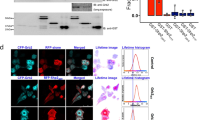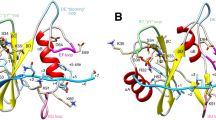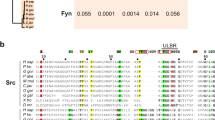Abstract
Previously, we demonstrated that the Src tyrosine kinase interacts with the Shp-2 tyrosine phosphatase. To determine whether Shp-2 regulates Src kinase activity, we measured Src activity in cells overexpressing wild-type or catalytically-inactive C463S Shp-2. We observed a 2 – 3-fold increase in the specific activity of Src in both cell types and the increase did not appear to be due to dephosphorylation of Tyr 527 or phosphorylation of Tyr 416 on Src. Conversely, we observed a 2 – 3-fold decrease in the specific activity of Src when Shp-2 expression was inhibited. Using glutathione S-transferase-fusion proteins, we demonstrated that Shp-2 binds to the SH3 domain of Src. Our findings reveal that the Shp-2 tyrosine phosphatase can regulate the Src tyrosine kinase by a non-enzymatic mechanism. We also found that the phosphatase activity of Shp-2 immunoprecipitates is downregulated in cells transformed by Src or other proteins, and that Shp-2 preferentially associates with the membrane fraction of transformed cells. We suggest that membrane-association of Shp-2 is important for regulating Shp-2 activity.
This is a preview of subscription content, access via your institution
Access options
Subscribe to this journal
Receive 50 print issues and online access
$259.00 per year
only $5.18 per issue
Buy this article
- Purchase on Springer Link
- Instant access to full article PDF
Prices may be subject to local taxes which are calculated during checkout






Similar content being viewed by others
References
Bennett AM, Tang TL, Sugimoto S, Walsh CT and Neel BG. . 1994 Proc. Natl. Acad. Sci. USA 91: 7335–7339.
Brown MT and Cooper JA. . 1996 Biochim. Biophys. Acta 1287: 121–114.
Cartwright CA, Eckhart W, Simon S and Kaplan PL. . 1987 Cell 49: 83–91.
Chang BY, Conroy KB, Machleder EM and Cartwright CA. . 1998 Mol. Cell. Biol. 18: 3245–3256.
Cloutier J-F and Veillette A. . 1996 EMBO J. 15: 4909–4918.
Cossette LJ, Hoglinger O, Mou L and Shen S-H. . 1996 Exp. Cell Res. 223: 459–466.
Dean NM, McKay R, Condon TP and Bennett CF. . 1994 J. Biol. Chem. 269: 16416–16424.
den Hertog J, Pals CEGM, Peppelenbosch MP, Tertoolen LGJ, de Laat SW and Kruijer W. . 1993 EMBO J. 12: 3789–3798.
Erpel T, Superti-Furga G and Courtneidge SA. . 1995 EMBO J. 14: 963–975.
Fang KS, Sabe H, Saito H and Hanafusa H. . 1994 J. Biol. Chem. 269: 20194–20200.
Feng G-S, Hui C-C and Pawson T. . 1993 Science 259: 1607–1610.
Fujioka Y, Matozaki T, Noguchi T, Iwamatsu A, Yamao T, Takahashi N, Tsuda M, Takada T and Kasuga M. . 1996 Mol. Cell. Biol. 16: 6887–6899.
Guan KL and Dixon JE. . 1990 Science 249: 553–556.
Guan KL, Broyles SS and Dixon JE. . 1991 Nature 350: 359–362.
Guy CT, Muthuswamy SK, Cardiff RD, Soriano P and Muller WJ. . 1994 Genes Dev. 8: 23–32.
Hof P, Pluskey S, Dhe-Paganon S, Eck MJ and Schoelson SE. . 1998 Cell 92: 441–450.
Jove R, Kornbluth S, Hanafusa H. . 1987 Cell 50: 937–943.
Kazlauskas A, Feng G-S, Pawson T and Valius M. . 1993 Proc. Natl. Acad. Sci. USA 90: 6939–6942.
Kharitonenkov A, Chen Z, Sures I, Wang H, Schilling J and Ullrich A. . 1997 Nature 386: 181–186.
Kmiecik TE and Shalloway D. . 1987 Cell 49: 65–73.
Koong AC, Chen EY, Mivechi NF, Denko NC, Stambrook P and Giaccia AJ. . 1994 Cancer Res. 54: 5273–5279.
Kypta RM, Goldberg Y, Ulug ET and Courtneidge SA. . 1987 Cell 62: 481–492.
Lechleider RJ, Robert M, Freeman J and Neel BG. . 1993a J. Biol. Chem. 268: 13434–13438.
Lechleider RJ, Sugimoto S, Bennett AM, Kashishan A, Cooper JA, Shoelson SE, Walsh CT and Neel BG. . 1993b J. Biol. Chem. 268: 21478–21481.
Li W, Nishimura R, Kashishian A, Batzer AG, Kim WJH, Cooper JA and Schlessinger J. . 1994 Mol. Cell. Biol. 14: 509–517.
Lipsich LA, Lewis AJ and Brugge JS. . 1983 J. Virol. 48: 352–360.
Luo KX, Hurley TR and Sefton B. . 1991 Methods Enzymol. 201: 149–152.
Milarski KL and Saltiel AR. . 1994 J. Biol. Chem. 269: 21239–21243.
Moarefi I. . 1997 Nature 385: 650–653.
Nada S, Okada M, MacAuley A, Cooper JA and Nakagawa H. . 1991 Nature 351: 69–72.
Okada M and Nakagawa H. . 1989 J. Biol. Chem. 264: 20886–20893.
Park J and Cartwright CA. . 1995 Mol. Cell. Biol. 15: 2374–2382.
Peng ZY and Cartwright CA. . 1995 Oncogene 11: 1955–1962.
Piwnica-Worms H, Saunders KB, Roberts TM, Smith AE and Cheng SH. . 1987 Cell 49: 75–82.
Reynolds AB, Vila J, Lansing TJ, Potts WM, Weber MJ and Parsons TJ. . 1987 EMBO J. 6: 2359–2364.
Roche S, Koegl M, Barone MV, Roussel MF and Courtneidge SA. . 1995 Mol. Cell. Biol. 15: 1102–1109.
Sicheri F, Moarefi I and Kuriyan J. . 1997 Nature 385: 602–609.
Somani A-K, Bignon JS, Mills GB, Siminovitch KA and Branch DR. . 1997 J. Biol. Chem. 272: 21113–21119.
Streuli M, Krueger NX, Hall LR, Schlossman SF and Saito H. . 1988 J. Exp. Med. 168: 1523–1530.
Streuli M, Krueger NX, Thai T, Tang M and Saito H. . 1990 EMBO J. 9: 2399–2407.
Tauchi T, Feng G-S, Shen R, Song HY, Donner D, Pawson T and Broxmeyer HE. . 1994 J. Biol. Chem. 269: 15381–15387.
Tonks NK and Neel BG. . 1996 Cell 87: 365–368.
Twamley-Stein GM, Pepperkok R, Ansorge W and Courtneidge SA. . 1993 Proc. Natl. Acad. Sci. USA 90: 7696–7700.
Vogel W, Lammers R, Huang J and Ullrich A. . 1993 Science 259: 1611–1614.
Wong L and Johnson GR. . 1996 J. Biol. Chem. 271: 20981–20984.
Xu W, Harrison SC and Eck MJ. . 1997 Nature 385: 595–602.
Yin T, Shen R, Feng G-S and Yang Y-C. . 1997 J. Biol. Chem. 272: 1032–1037.
Zheng XM, Wang Y and Pallen CJ. . 1992 Nature 359: 336–339.
Acknowledgements
We thank Rachel Harte for assistance with experiments and Rachel Harte and Karen Conroy for help with analysing data and preparing figures. We thank Tony Pawson for the gift of pBS-Shp-2, Sara Courtneidge for kindly providing the ΔSH3 src mutant, David Shalloway for v-Src transformed NIH3T3 cells, Amato Giaccia for Ha-Ras[V12]-transformed NIH3T3 cells and Joosang Park for generating pGEXsrc plasmids. This work was supported initially by an American Cancer Society Grant BE-246 and then by a National Institutes of Health (NIH) Grant 2R01 DK43743-07 (to CAC), a Deutsche Forschungsgemeinschaft Postdoctoral Fellowship Award (to AOW) and a NIH NIDDK Training Grant T32 DK07056 (Z-YP).
Author information
Authors and Affiliations
Rights and permissions
About this article
Cite this article
Walter, A., Peng, ZY. & Cartwright, C. The Shp-2 tyrosine phosphatase activates the Src tyrosine kinase by a non-enzymatic mechanism. Oncogene 18, 1911–1920 (1999). https://doi.org/10.1038/sj.onc.1202513
Received:
Revised:
Accepted:
Published:
Issue Date:
DOI: https://doi.org/10.1038/sj.onc.1202513
Keywords
This article is cited by
-
Gi/o protein-coupled receptor inhibition of beta-cell electrical excitability and insulin secretion depends on Na+/K+ ATPase activation
Nature Communications (2022)
-
A novel role for ezrin in breast cancer angio/lymphangiogenesis
Breast Cancer Research (2014)
-
Leptin induces upregulation of sphingosine kinase 1 in oestrogen receptor-negative breast cancer via Src family kinase-mediated, janus kinase 2-independent pathway
Breast Cancer Research (2014)
-
Amplification of MPZL1/PZR promotes tumor cell migration through Src-mediated phosphorylation of cortactin in hepatocellular carcinoma
Cell Research (2014)
-
The tyrosine phosphatase Shp2 (PTPN11) in cancer
Cancer and Metastasis Reviews (2008)



